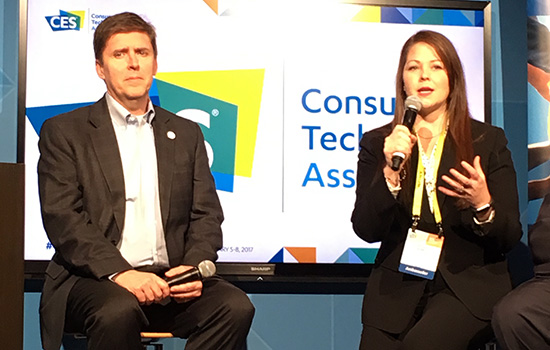Researcher presents at Consumer Electronics Show
RIT’s Golisano Institute for Sustainability reveals findings at Consumer Electronics Show
Callie Babbitt, right, associate professor in the Golisano Institute for Sustainability, with Walter Alcorn, vice president for environmental affairs and industry sustainability at the Consumer Technology Association, presents initial results of a comprehensive materials baseline study for all consumer electronics sold into the U.S. market for the past 25 years at CES on Jan. 7.
The initial results of a comprehensive materials baseline study for all consumer electronics sold into the U.S. market for the past 25 years were unveiled at the Consumer Electronics Show in Las Vegas on Jan. 7.
The study found that while the number and types of consumer technology products sold have increased, the net material consumption has declined to levels not seen since the early 1990s.
The research findings were presented by Callie Babbitt, associate professor in the Golisano Institute for Sustainability (GIS) at Rochester Institute of Technology. In collaboration with the Staples Sustainable Innovation Lab (housed at GIS) and the Consumer Technology Association, Babbitt and a team of researchers carried out a comprehensive analysis of the “material footprint” of consumer technology being used in U.S. households from 1990 to 2015. The team focused on about 20 of the most common consumer technologies during this time, including TVs, phones, computers, monitors and entertainment devices.
“We studied the number and type of products being sold, how many were in an average household, and the ultimate flow into the waste stream,” said Babbitt.
The team also looked at how product weight and material content changed over the same time period. Data came from a wide variety of sources, including the Consumer Technology Association, the U.S. Environmental Protection Agency, scientific literature, and laboratory studies of material content in electronics. More than 100 different products were disassembled to find out what materials they contained.
“Most of this material reduction since the early 1990s is due to phasing out of large, bulky products like cathode ray tube televisions and substitution with lightweight flat panel displays,” said Babbitt. “In addition, many products are being designed with lighter materials, like aluminum instead of plastic or steel.”
The researchers also observed a greater “device convergence” in recent years, where multifunctional mobile devices, such as smart phones, are taking the place of many products consumers would have owned separately before, like MP3 players or digital cameras.
“When we looked at specific materials, a key finding was that major materials of concern used historically to enable consumer technology products, like lead and mercury, have declined, either due to technological progress or success of policy initiatives,” said Babbitt. “However, there are new opportunities for study and green innovation. For example, more mobile products mean a greater demand for lithium-ion batteries, and there is a clear opportunity to proactively develop recycling systems to target these emerging waste streams.”
Walter Alcorn, vice president for environmental affairs and industry sustainability at the Consumer Technology Association called the research “groundbreaking” for the industry. “This will give us the framework that we can start to, in an intelligent and macro way, identify what materials are going into our products, where there may be issues in terms of material scarcity and issues of toxicity.”
Mark Buckley, vice president of environmental affairs at Staples, said the data in the study will set the tone for a stronger circular economy, which refers to an industrial economy that is restorative by intention and eliminates waste through thoughtful design.
“In the future it’s going to be really important to start to predict where those materials are going,” he said. “The converging technologies in new products pose new challenges. Looking in the rear-view mirror, this data is going to help inform us and help predict how the model should look going forward.”
Babbitt said the baseline provides the foundation for the next phase of research, where the team will use the model to analyze material used in emerging products. “Like some of the new gadgets that we are seeing at CES,” she said.
Also at CES last Saturday, Nabil Nasr, associate provost and director of GIS participated in a panel discussion addressing emerging sustainability issues in light of the new administration and Congress.
Panelists debated such questions as whether the sharing economy will lead to sustainable consumption in an economy powered by consumer technology, and whether innovation will lead the global economy towards growth while still reducing humanity’s environmental footprint.
The panel was moderated by Barnes Johnson, director of the Office of Resource Conservation and Recovery in the U.S. Environmental Protection Agency’s Office of Land and Emergency Management.
In addition to Nasr and Alcorn, the panel included executives from Google, Samsung and other governmental officials.














